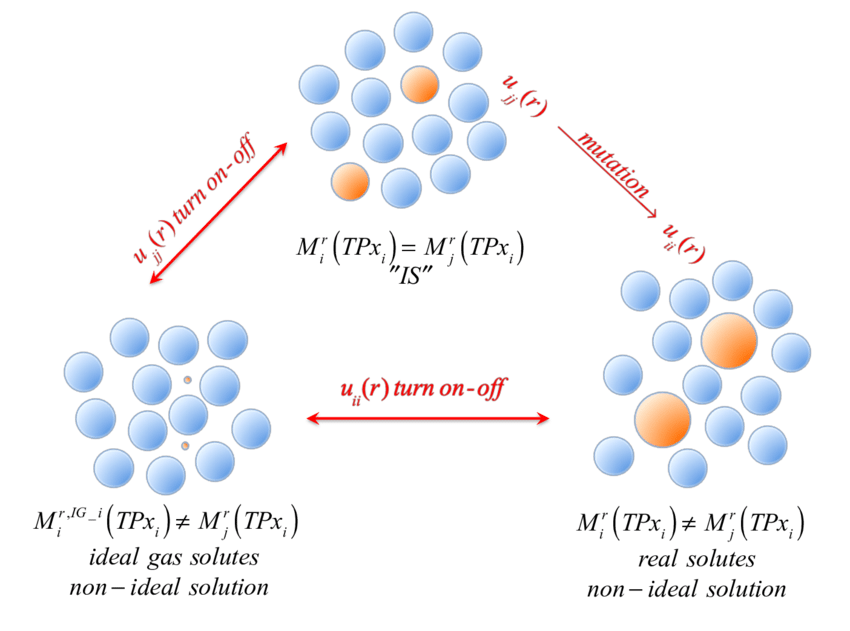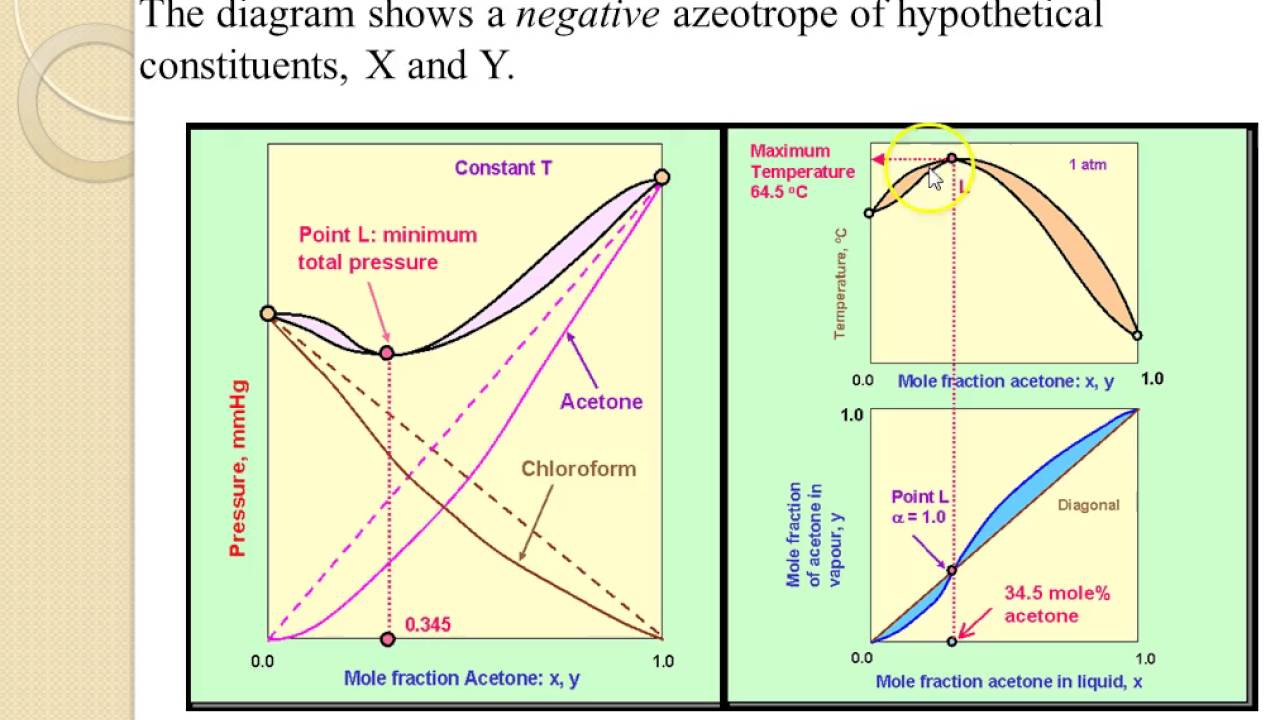Table of Contents
What is negative azeotrope?
In general, a negative azeotrope boils at a higher temperature than any other ratio of its constituents. Negative azeotropes are also called maximum boiling mixtures or pressure minimum azeotropes. An example of a negative azeotrope is hydrochloric acid at a concentration of 20.2% and 79.8% water (by mass).
What type of azeotropes is formed by negative deviation?
Maximum boiling azeotrope
Can azeotropes be positive or negative?
Positive or Negative: A positive azeotrope or minimum-boiling azeotrope forms when the boiling point of the mixture is lower than that of any of its constituents. A negative azeotrope or maximum-boiling azeotrope forms when the boiling point of the mixture is higher than that of any of its constituents.
What are the different types of azeotropes?
We can classify azeotropes into five classes. They are homogeneous azeotrope, heterogeneous azeotrope, binary azeotrope, maximum boiling azeotrope and minimum boiling azeotrope
What are the types of azeotropes?
Positive or Negative: A positive azeotrope or minimum-boiling azeotrope forms when the boiling point of the mixture is lower than that of any of its constituents. A negative azeotrope or maximum-boiling azeotrope forms when the boiling point of the mixture is higher than that of any of its constituents.
What causes positive azeotrope?
We can classify azeotropes into five classes. They are homogeneous azeotrope, heterogeneous azeotrope, binary azeotrope, maximum boiling azeotrope and minimum boiling azeotrope
What is a azeotrope?
Azeotropes form when there is a ‘deviation from Raoult’s law’: A solution that shows positive deviation from Raoult’s law forms a minimum boiling azeotrope. A very well-known example would be the azetrope that forms from a ethanol and water mixture when it is approximately 95% ethanol by volume.
What are the characteristics of azeotrope?
Azeotropes form when there is a ‘deviation from Raoult’s law’: A solution that shows positive deviation from Raoult’s law forms a minimum boiling azeotrope. A very well-known example would be the azetrope that forms from a ethanol and water mixture when it is approximately 95% ethanol by volume.
What type of azeotrope is formed by negative deviation?
azeotrope, in chemistry, a mixture of liquids that has a constant boiling point because the vapour has the same composition as the liquid mixture. The boiling point of an azeotropic mixture may be higher or lower than that of any of its components.
How do you identify azeotropes?
Maximum boiling azeotrope
What type of azeotropes are formed by positive and negative deviation from Raoult’s Law?
1 Answer. Azeotropes-A liquid mixture which distills at constant temperature without undergoing any change in composition is called azeotropes. Minimum boiling azeotropes is formed by positive deviation from Raoult’s law.
What type of azeotrope is formed by a non ideal solution?

Assertion : Azeotropic mixtures are formed only by non ideal solutions and they may have boiling points either greater than both the components or less than both the components. Reason : The composition of the vapour phase is same as that of the liquid phase of an azeotropic mixture.
What type of deviation shows the formation of maximum boiling azeotropes?
Negative deviation from Raoultx27s
What are negative azeotropes?
In general, a negative azeotrope boils at a higher temperature than any other ratio of its constituents. Negative azeotropes are also called maximum boiling mixtures or pressure minimum azeotropes. An example of a negative azeotrope is hydrochloric acid at a concentration of 20.2% and 79.8% water (by mass).
What are the two types of azeotrope?
There are two types of azeotropes: minimum boiling azeotrope and maximum boiling azeotrope.
How many types of azeotropic mixtures are there?
Ternary Azeotrope u2013 Azeotropes that have three constituents are called ternary azeotropes. For example, an azeotropic mixture of acetone, methanol, and chloroform. Those mixtures whose constituents possess different boiling points are called non u2013 azeotropic mixtures or zeotropic mixtures.
What are azeotropes in chemistry?
azeotrope, in chemistry, a mixture of liquids that has a constant boiling point because the vapour has the same composition as the liquid mixture. The boiling point of an azeotropic mixture may be higher or lower than that of any of its components.
What are azeotropic mixtures explain its types with examples?
Solution : Azeotropic mixture is mixture of two or more liquids having constant boiling point. The most familiar example of an azeotropic mixture is a mixture of ethanol and water in the ratio of 95.6:4.4. It boils at a temperature of `78.5^()`C.
What are azeotropes give examples of both types of azeotropes?
Ternary Azeotrope u2013 Azeotropes that have three constituents are called ternary azeotropes. For example, an azeotropic mixture of acetone, methanol, and chloroform. Those mixtures whose constituents possess different boiling points are called non u2013 azeotropic mixtures or zeotropic mixtures.
What are the types of azeotropic mixture?
They are:
- Minimum Boiling Azeotropes or Negative Azeotrope. Azeotropic mixtures with a higher boiling point in their constitutions are maximum boiling azeotropes.
- Maximum Boiling Azeotropes or Positive Azeotrope.
- Heterogeneous and Homogeneous Azeotropes.
- Azeotropes Based on the Number of Constituents.
How many types of azeotropic systems are there?
There are two types of azeotropes: minimum boiling azeotrope and maximum boiling azeotrope. A solution that shows greater positive deviation from Raoult’s law forms a minimum boiling azeotrope at a specific composition.
What causes an azeotrope to form?
Azeotropes are a mixture of at least two different liquids. Their mixture can either have a higher boiling point than either of the components or they can have a lower boiling point. Azeotropes occur when fraction of the liquids cannot be altered by distillation
Why is ethanol and water an azeotrope?
Positive or Negative: A positive azeotrope or minimum-boiling azeotrope forms when the boiling point of the mixture is lower than that of any of its constituents. A negative azeotrope or maximum-boiling azeotrope forms when the boiling point of the mixture is higher than that of any of its constituents.
How do you confirm azeotrope?
Ethanol and water are azeotropes because they have the same boiling point. Also, the vapour composition of this mixture is the same.
What is an azeotrope in chemistry?
azeotrope, in chemistry, a mixture of liquids that has a constant boiling point because the vapour has the same composition as the liquid mixture. The boiling point of an azeotropic mixture may be higher or lower than that of any of its components.

